staghorn sumac
(Rhus typhina)
Conservation • Description • Habitat • Ecology • Use • Distribution • Taxonomy
|
|
||||||||||||||
Description |
Staghorn sumac is a fast-growing, 4′ to 15′ tall shrub or, rarely, small tree. It rises on a single trunk from long-creeping branched rhizomes. In Minnesota mature plants are usually 4′ to 15′ tall and 2″ to 4″ in diameter. Large individuals can reach over 32′ in height and 8″ in diameter. It often forms dense colonies with the oldest and tallest individuals in the center surrounded by progressively younger and shorter individuals. It is a short-lived tree, usually surviving no more than 50 years. The trunk is forked and occasionally branched. The crown is open, irregular, and rounded or flat-topped. The bark on young parts is thin, smooth, and dark brown to yellowish-brown with prominent lenticels. As it ages it becomes slightly scaly. The upper branchlets are densely covered with with short, brown, hairs. The lower trunk and branches are hairless and woody. In winter the leafless, velvety branches have the appearance of antlers on a buck deer, giving the plant its common name. The twigs are very stout, tan to slightly reddish, and densely hairy. Older branches have prominent lenticels, while younger branches and twigs do not. When broken the branches exude a yellowish sap. There is no terminal bud—the branches end in a cluster of fruits or a dead stub. The lateral buds are cone-shaped, 3 ⁄16″ to ¼″ long, and covered with pale brown, velvety hairs. The leaf scar is crescent or horse-shoe shaped and has 3 bundle scars. The leaf scar almost completely surrounds the bud. The leaves are deciduous, alternate, and pinnately compound. They are 12″ to 24″ long and are divided into 11 to 31 leaflets. They are on 1¼″ to 4″ long, densely woolly or felty leaf stalks. The central stalk of the leaf to which the leaflets are attached is slightly reddish and densely hairy and is not winged. The leaflets are stalkless or on very short stalks. They are arranged in opposite or slightly alternate pairs with 1 terminal leaflet. They are lance-shaped, 2″ to 4¾″ long, and ¾″ to 1¾″ wide. They are rounded or slightly heart-shaped at the base and taper to a long point at the tip. The upper surface is dark green and nearly hairless. The lower surface is pale green to sometimes nearly white, moderately to densely hairy along the veins, and covered with a whitish, waxy coating (glaucous). The margins have fine, sharp, forward-pointing teeth or are rarely pinnately lobed. In autumn the leaves turn bright orange, red, or purple. Male and female flowers are borne on separate plants. The inflorescence is a dense, erect, 2¾″ to 10″ long, 1½″ to 2″ wide, branched cluster (panicle) at the end of many of the branchlets. Each panicle is made up of 100 to 700 flowers. Female panicles are more compact than male panicles. The flowers are tiny and yellowish-green. They appear in early June to mid-July after the leaves are fully developed. The fruit is fleshy and surrounds a single seed (drupe). It is dark red, ⅛″ to 3 ⁄16″ long and wide, and covered with bright red, needle-like hairs. They are held in dense, upright clusters. They ripen from August to September and persist for most of the winter. |
Height |
4′ to 15′ |
Flower Color |
Yellowish-green |
Similar Species |
Smooth sumac (Rhus glabra) branches, twigs, and rachis are hairless. The drupes are hairless but densely covered with short, nipple-like bumps. |
Habitat |
Dry. Abandoned fields, forest edges, thickets, roadsides. Full sun. |
Ecology |
Flowering |
Early June to mid-July |
Pests and Diseases |
|
Use |
|
Distribution |
||
|
Sources |
|
| 1/30/2024 | ||
Nativity |
||
Native |
||
Occurrence |
||
Common |
||
Taxonomy |
|
Kingdom |
|
Division |
Tracheophyta (Vascular Plants) |
Subdivision |
Spermatophytina (Seed Plants) |
Class |
|
Order |
Sapindales (soapberries, cashews, mahoganies, and allies) |
Family |
Anacardiaceae (cashew) |
Subfamily |
Anacardioideae (cashews, sumacs, and allies) |
Genus |
Rhus (sumacs) |
Subordinate Taxa |
|
|
|
Synonyms |
|
Datisca hirta Rhus hirta Rhus typhina var. laciniata |
|
Common Names |
|
staghorn sumac stag's-horn sumach sumac Velvet sumac vinegar tree Virginia sumac |
|
Glossary
Bundle scar
Tiny raised area within a leaf scar, formed from the broken end of a vascular bundle.
Drupe
A fleshy fruit with a single hard, stone-like core, like a cherry or peach.
Glaucous
Pale green or bluish gray due to a whitish, powdery or waxy film, as on a plum or a grape.
Lenticel
A corky, round or stripe-like, usually raised, pore-like opening in bark that allows for gas exchange.
Panicle
A pyramidal inflorescence with a main stem and branches. Flowers on the lower, longer branches mature earlier than those on the shorter, upper ones.
Pinnate
On a compound leaf, having the leaflets arranged on opposite sides of a common stalk. On a bryophyte, having branches evenly arranged on opposite sides of a stem.
Rhizome
A horizontal, usually underground stem. It serves as a reproductive structure, producing roots below and shoots above at the nodes.
Winged leaf stalk
A leaf stalk with a leaf-like or membrane-like extension along both sides.
Visitor Photos |
||
Share your photo of this plant. |
||
This button not working for you? |
||
Luciearl |
||
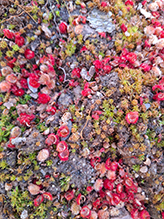 |
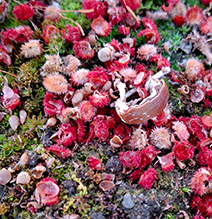 |
|
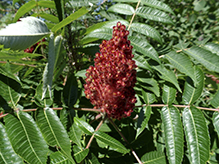 |
||
Alfredo Colon |
||
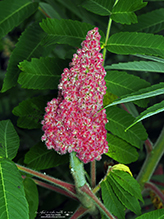 |
 |
|
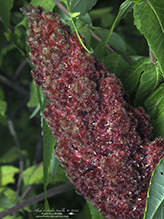 |
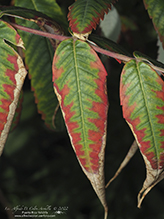 |
|
Dan W. Andree |
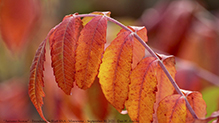 |
Autumn Sumac... |
Randy |
||
Staghorn sumac as a foundation planting, December 2016, Freeborn County, MN |
||
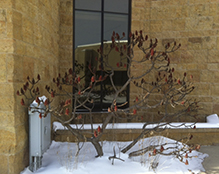 |
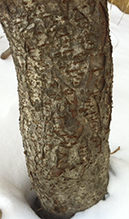 |
|
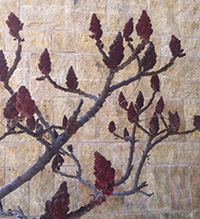 |
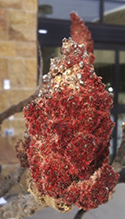 |
|
MinnesotaSeasons.com Photos |
||
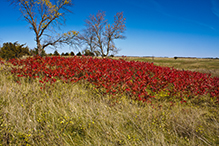 |
||
Habitat |
|
|
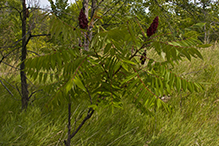 |
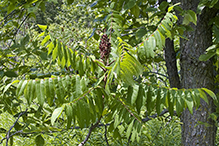 |
|
Plant |
Plant |
|
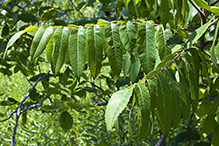 |
 |
|
Leaf |
Stem |
|
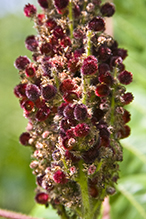 |
 |
|
Infructescence |
Infructescence |
|
 |
||
Fall |
|

Slideshows |
Staghorn Sumac |
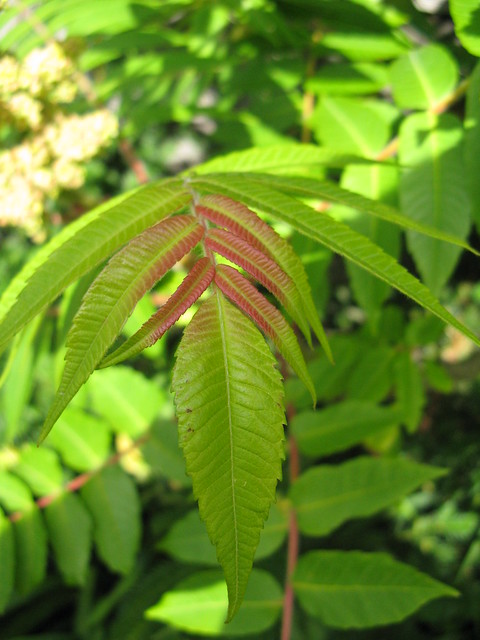
|
About
Staghorn Sumac (Rhus typhina). |
Rhus typhina |
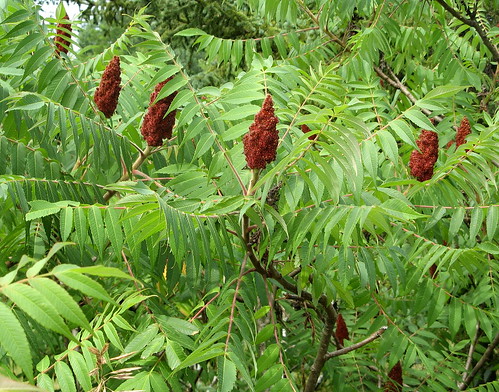
|
About
Staghorn Sumac |
Rhus typhina |
About
Published on Jul 31, 2014 Description |

Visitor Videos |
||
Share your video of this plant. |
||
This button not working for you? |
||
|
Other Videos |
||
Rhus typhina |
About
Published on Feb 27, 2014
|
Staghorn sumac (rhus typhina) identification video |
About
Published on Jul 22, 2013 Staghorn sumac (rhus typhina) identification video |

Visitor Sightings |
||
Report a sighting of this plant. |
||
This button not working for you? |
||
| Luciearl April 2025 |
Location: Fairview Twp. |
 |
Alfredo Colon |
Location: Albany, NY |
 |
| Alfredo Colon 8/21/2022 |
Location: Albany, NY |
 |
| Alfredo Colon 8/16/2022 |
Location: Albany, NY |
 |
| Alfredo Colon 8/3/2022 |
Location: Albany, NY |
 |
| Dan W. Andree 9/30/2021 |
Location: Frenchman’s Bluff SNA Autumn Sumac... |
 |
| Luciearl 7/24/2020 |
Location: Cass County |
 |
| Randy December, 2016 |
Location: Freeborn County, MN Staghorn sumac as a foundation planting |
 |
MinnesotaSeasons.com Sightings |
||

|
Created: Last Updated: © MinnesotaSeasons.com. All rights reserved. |
